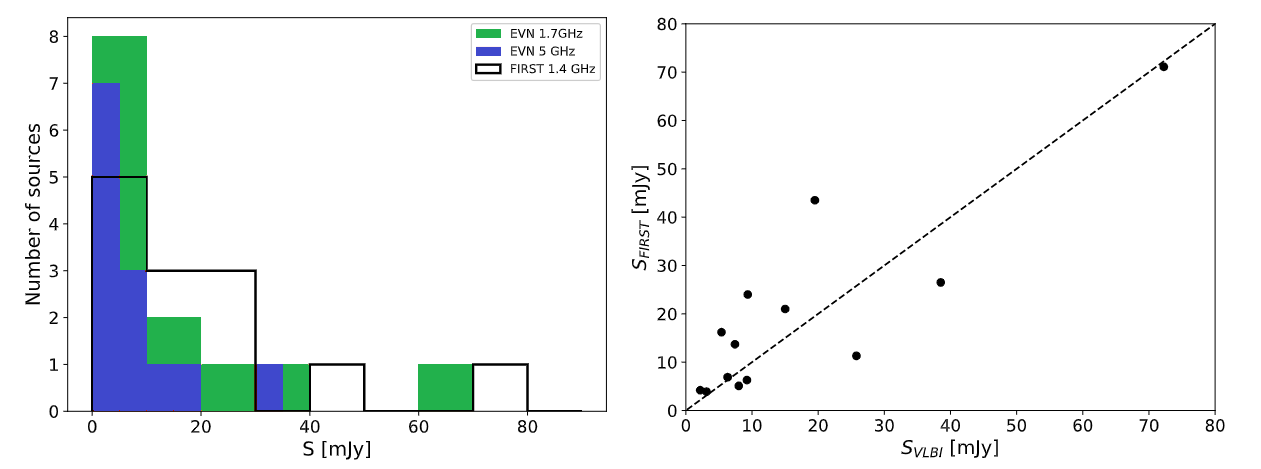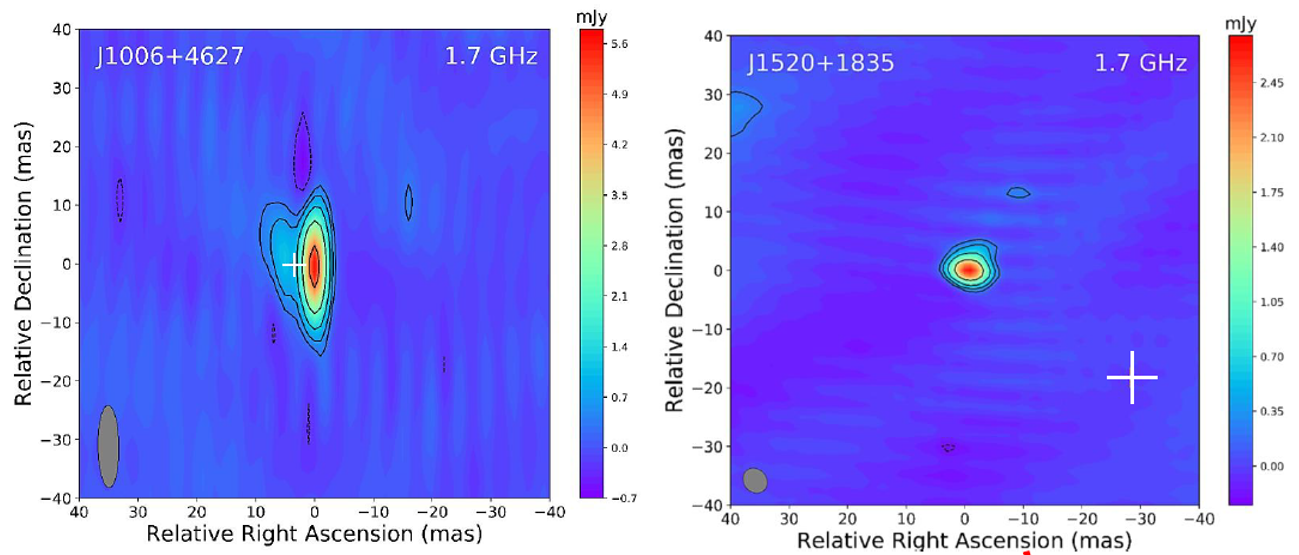
Radio-loud Quasars above Redshift 4: VLBI Imaging of an Extended Sample
by Máté Krezinger (ELTE, Hungary), Krisztina Perger (CSFK, Hungary), Krisztina É. Gabányi (ELTE, Hungary), Sándor Frey (CSFK, Hungary), Leonid I. Gurvits (JIVE, the Netherlands), Zsolt Paragi (JIVE, the Netherlands), Tao An (SHAO, China), Yingkang Zhang (SHAO, China), Hongmin Cao (SHNU, China), Tullia Sbarrato (INAF, Italy)
Quasars in the early Universe (z < 4) provide excellent tools to study the evolution of galaxies and supermassive black holes. These high-redshift sources are tracers of processes from early-time star forming activity to primordial active galactic nuclei (AGN). The latter are powered by accretion onto supermassive black holes (SMBH) with masses of up to 1010 𝑀⊙ (Sbarrato, 2021). In recent years, a couple of high-redshift jetted sources were revealed by various radio sky surveys. Because only about 10% of the AGN have jets (radio quasars) and distant quasars tend to be faint, these sources are harder to detect and the high-redshift domain will not be as populated with well-studied objects as the more nearby Universe.

To date, we know ~200 radio quasars at above redshift 4 (Perger et al., 2017). From these sources, only ~60 were imaged with very long baseline interferometry (VLBI). With VLBI, we can better classify the already known high-redshift radio sources, since the technique can distinguish between a compact core and a more extended radio emission. For blazars, we expect to find compact radio cores with flat spectrum and Doppler-boosted emission. In some cases, high-resolution milliarcsecond (mas) scale observations of blazar candidates – identified via X-ray observations – reveal some extended, or even symmetric radio structures with steep spectra which indicates that there are misaligned sources misclassified as blazars. To observe and classify more and more sources is essential to examine a more complete sample than we have now.
In addition to the VLBI observations, the recent Gaia optical astrometric positions also help in the classification process. The optical position is closely related to the accretion disk around the SMBH, while the VLBI position points to the brightest and most compact radio emission in the jet. In some cases, when there is bright, pc-scale optical synchrotron jet emission present, the optical position may be offset by up to a few mas along the VLBI jet direction (e.g. Kovalev et al., 2017). The angular separation between the two positions (optical and radio) can indicate whether we see a compact symmetric object (CSOs) or core–jet type object.
To extend the sample of VLBI imaged high-redshift quasars, we chose 13 radio-loud quasars from the list of Sbarrato et al. (2013) which contains 31 z > 4 blazar candidates with radio loudness R > 100. This way, the list of the VLBI imaged sources has been increased by 25%. They are all detected in the 1.4 GHz Very Large Array (VLA) Faint Images of the Radio Sky at Twenty-centimetres (FIRST) survey, with flux densities in the range 1 − 100 mJy (see Figure 1). Phase-referenced dual-frequency (1.6 and 5 GHz) observations were carried out with the European VLBI Network (EVN). EVN provides the best angular resolution and the highest sensitivity needed to image these distant and faint sources. Under the project code EG102, a total of 12 observing sessions were scheduled, started in 2017 December and ended in 2020 November. In addition to the elements of the EVN, antennas of the e-MERLIN were occasionally included in the observing network to trace the possible extended emission of the target sources. Most observing networks included long east–west baselines for the finest resolution.
During the analysis, we derived physical properties for the target sources in order to classify the radio quasars in our sample as blazar or non-blazar sources. We used the radio structure revealed by our EVN images and the fitted brightness distribution model parameters to describe the continuum radio spectra and to find possible flux density variability. Six of our targets were found to be variable. Additionally, the Gaia EDR3 optical coordinates were used to obtain more morphological information. We also checked in the literature for any available archival X-ray data to further constrain the class. All sources could be classified based on these observed and derived properties. Figure 2 shows EVN images of two example sources, one blazar and a compact symmetric object. We found that half of the sources are blazar-like objects with compact core–jet structures and flat spectrum, while the rest are unbeamed gigahertz-peaked spectrum sources or CSOs. Similar conclusions were found in previous studies (Coppejans et al. 2016, Cao et al. 2017). In the future, conducting further high-resolution VLBI surveys of high-redshift quasars is essential to achieve a more complete sample to study.

Published in Krezinger et al., 2022, ApJS, 260, 49